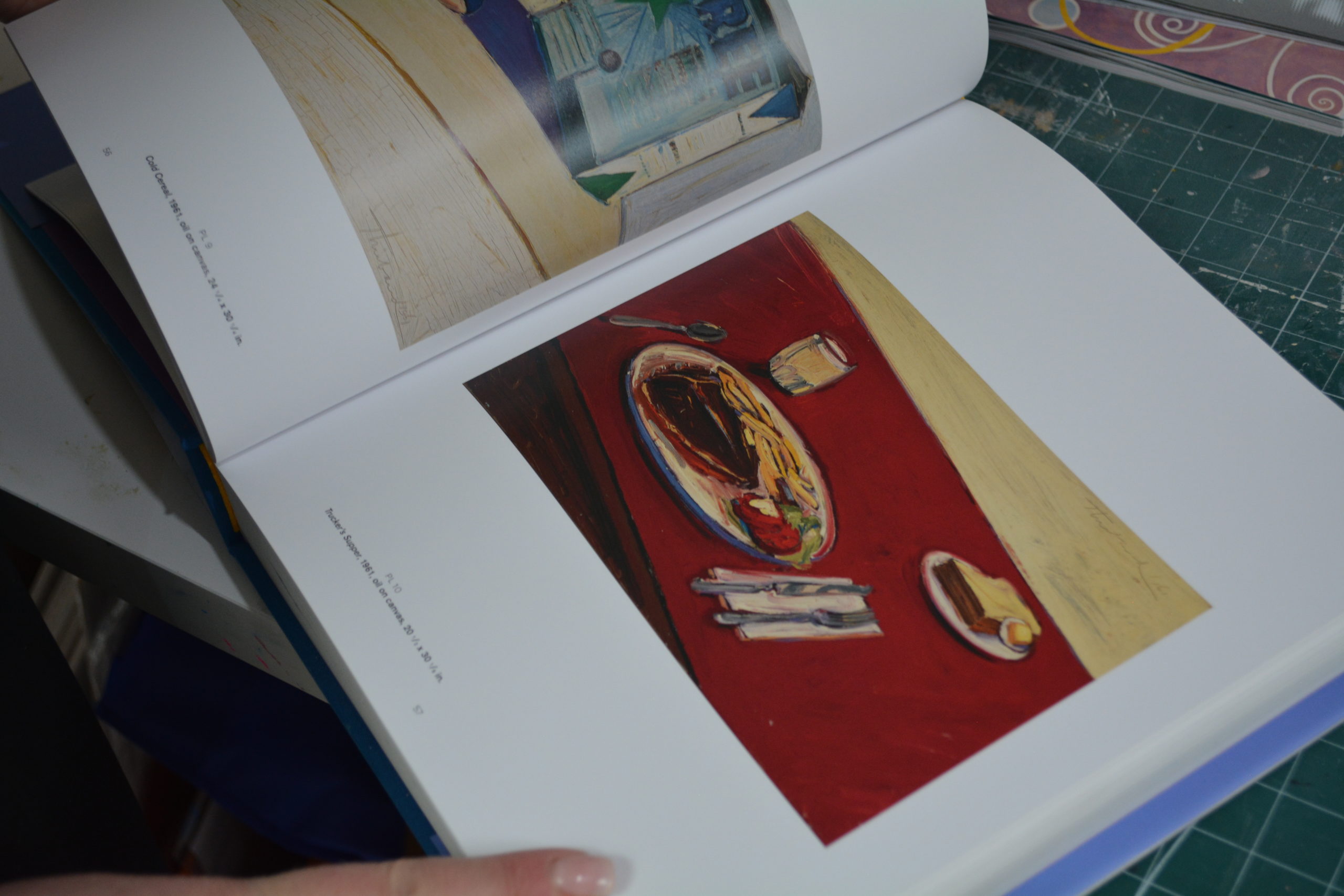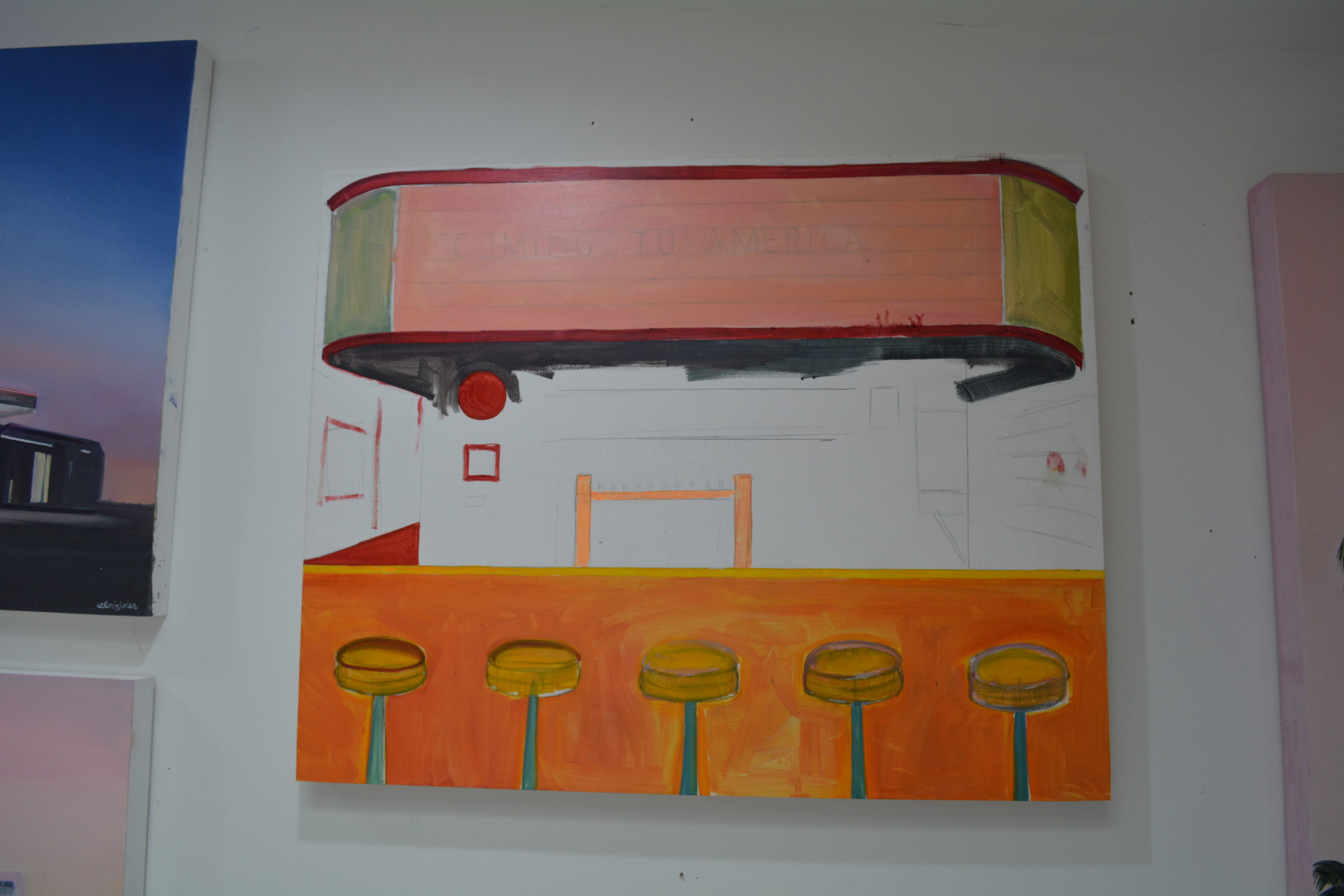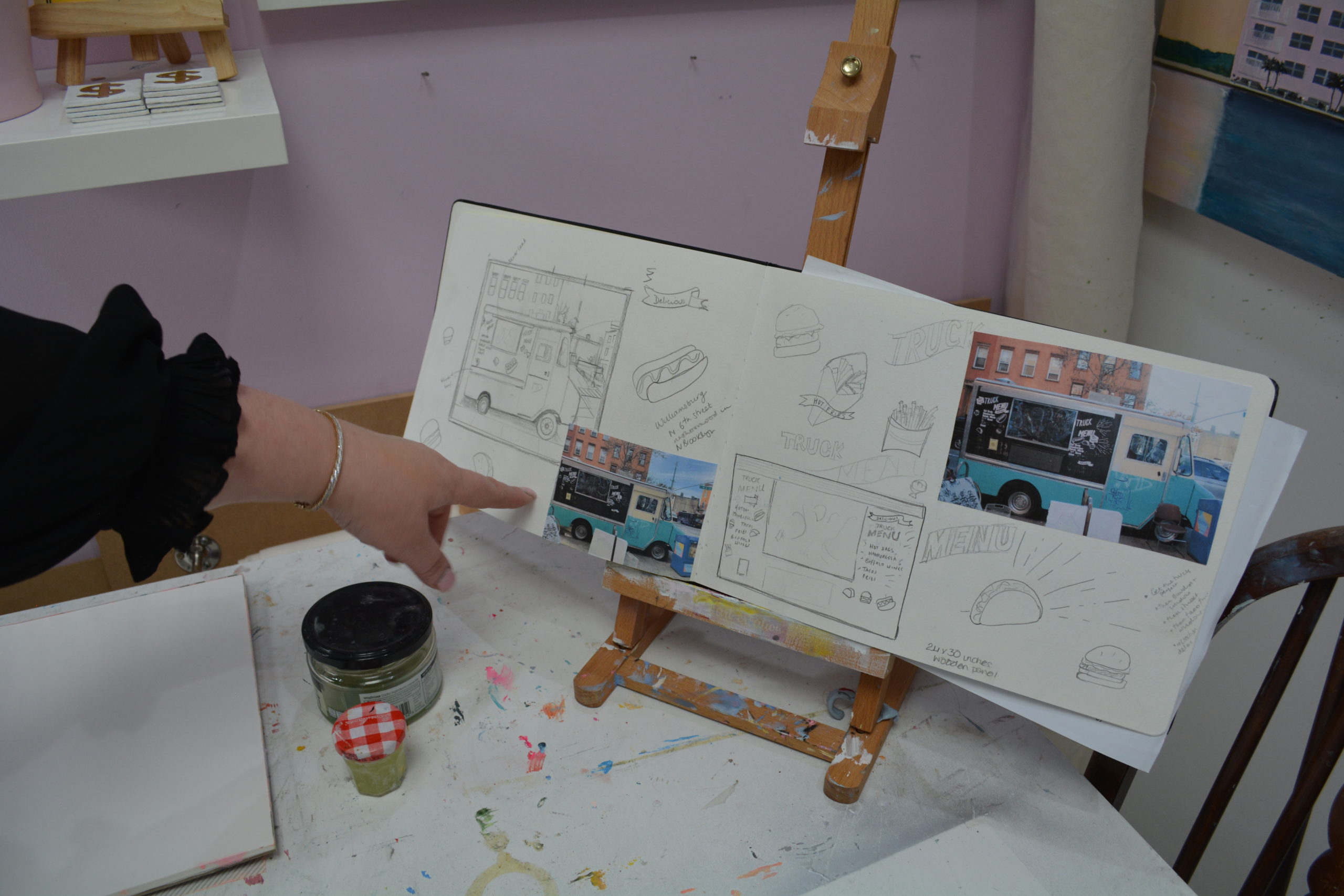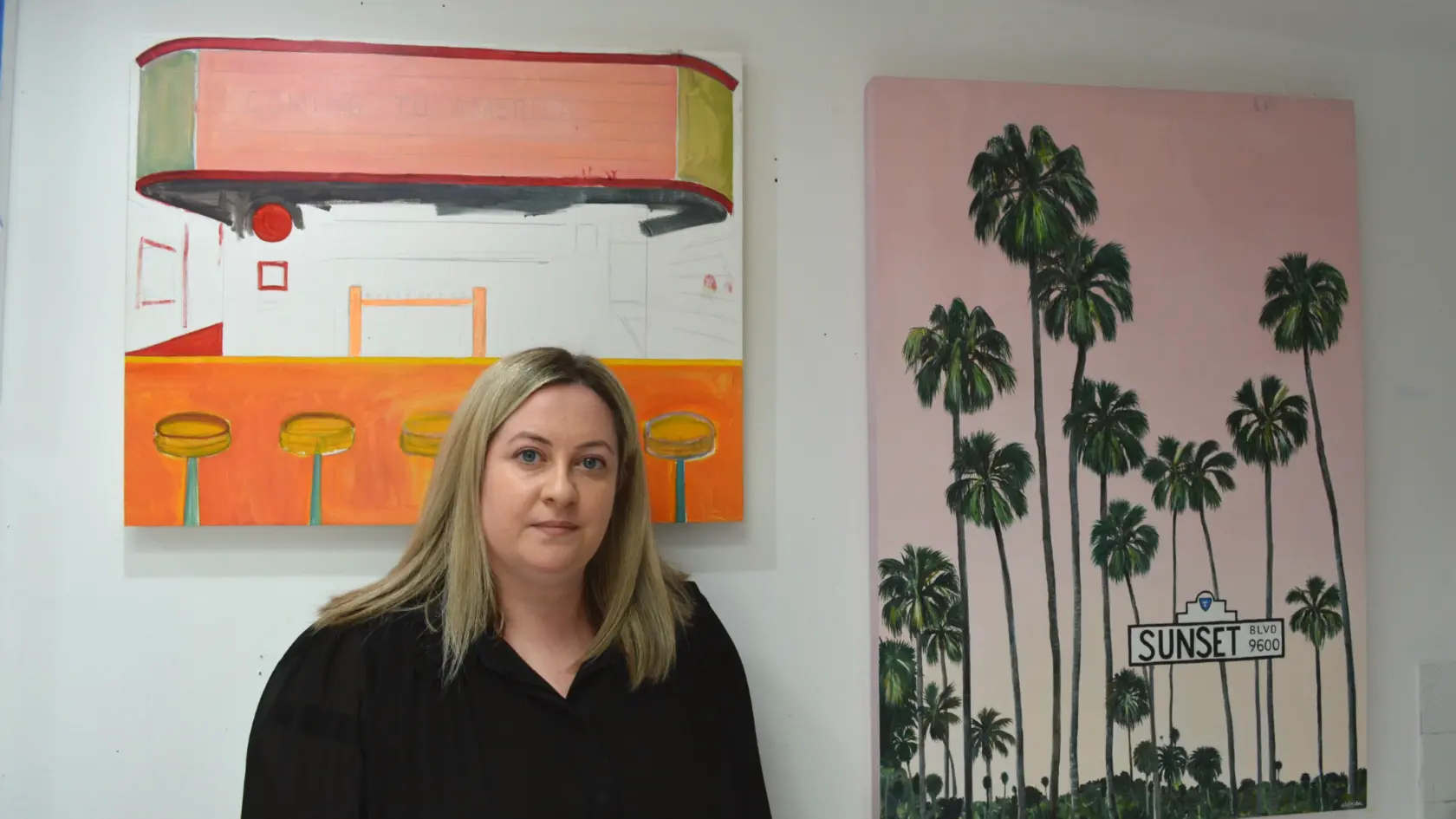By Zoë Goetzmann (@byzoesera)
Interview with Emma Loizides – Contemporary Art
This week, Cosimo: Studio Tours visits artist Emma Loizides’ studio in North London.
On a typical grey London day, Emma’s studio and home is a pink palace oasis (and the epitome of my art and home decor dreams). The walls of her house are covered entirely with art – her stunning salon-style gallery wall was one of the prime highlights of this studio visit.
Emma is a full-time artist and oil painter. She creates landscapes, cityscapes, and still lifes inspired by her international travels, popular brands, or branded, commercial imagery – inspired by her time spent living in the U.K. and the U.S.A.
Some of our favourite works by Emma include her London skyline paintings (including her recent work of the skyline overlooking Primrose Hill – which, as Loizides says in our interview, took her “two years” to complete due to the work’s massive scale).
Emma has exhibited work in the Royal Academy’s Summer School. She has shown work at Roy’s Art Fair and The Other Art Fair. Last year, the artist exhibited her work for the first time at START Art Fair at Saatchi Gallery.
This year, Emma will show her work at this upcoming Affordable Art Fair and Fresh Art Fair.

Zoë: Tell me about your ‘Artist Story.’ What made you want to become an artist?
Emma: I started quite late, I didn’t become a full-time artist till I was 40. I always loved being creative and making things as a kid. And I studied up to A Level. And then when I went to university, I really wanted to travel.
So I studied business, Business Management, and Spanish, then went into working in Canary Wharf, at HSBC. And then I must have been in my early 20s – I was coming out of work one day, and I saw a sign for an art club, like ‘A Lunchtime Art Club,’ and I thought, “I’d love that.”
And from then, I just started doing short courses at Central Saint Martins on Saturdays and I did summer school at the Slade [School of Fine Art] and just started painting in my spare time. Just always: ‘building it’ [my artistic practice].
I entered a show in Bedford, I think I was 27. And that was the first painting that I sold, and just kept at it since then. And then it was during the COVID [pandemic] I just started selling more and painting more. And I thought now I’m going to go for it full-time.
Zoë: Did you always had a passion for art? Did you do it when you were younger? And what made you not want to pursue it early on? Just timing?
Emma: I was always creative. But I think there aren’t really any artists in my family. And it’s, I guess I just thought I’m not going to make any money. I have to get a – you know – ‘office type job.’ It just didn’t occur to me that it was an option.
Zoë: Was there a turning point when you realised there was a potential to make money? Or did you take on? Did you start pursuing art just because you wanted to do it? Was it a ‘now or never situation?’
Emma: I think I was always edging towards it. And like applying for different things like applying to The Other Art Fair and the Affordable Art Fair.
And it was around that time when, just over a year and a half ago, just things started happening. I started selling more and I just thought: “Oh, I’m really going to give it a go now.”

Zoë: Wow. So can you tell me a little bit about your artistic practice and kind of the mediums you work with and the themes you explore?
Emma: Yeah, so I like to paint the city, I guess because I’m right in London. I genuinely work from photographs and sketches.
So for example, when I was at Canary Wharf when I was working in HSBC, I used to take my sketchbook and sit at lunchtime and just be sketching around the buildings and things. So I work from photographs and sketches.
I don’t work on location like I wouldn’t paint in the park because I find it too difficult with the weather – ‘London weather.’ So yeah, I work from my studio here. I work with oils all the time. I’m really slow. This one’s taken me two years [Emma gestures to the massive landscape/cityscape of the view from Primrose Hill behind us].
That’s the view from Primrose Hill. So I would go there, sketching my sketchbook and get an idea of what I wanted to paint. Then come back and make the canvas: it’s linen canvas, which I stretched it here and then built up loads of layers of oil paints.
Zoë: [There’s] also a slightly photographic feel to your work. I was wondering: are you able to explain how you’re able to [accomplish] this specific style of painting?
Or, how you’re able to create oil paintings that have a slightly photographic feel [or sentiment]? There’s a kind of flatness to the overall canvas. It’s really interesting.
Emma: I think it’s probably because I do work from photographs. So I’m copying from photographs, and then if I’m missing detail, or I’ll go back …
Zoë: You paint a lot of different locations. Is there a reason why you love painting [cities] or London so much [for example]? What appeals to you about [painting] cities and travel?
Emma: It’s just what [is] familiar to me. I also spent two years living in Las Vegas. And I did an internship there about 15 years ago. So I travelled around the coast and did a road trip from San Diego to San Francisco.
And I got a lot of photographs and sketches and stuff from around there. And I love the American landscape, and the flat architecture, and palm trees. So there’s quite a mix.
There’s an influence from America and the American landscape and then quite a lot of London cityscapes as well.

Zoë: There’s such a good positivity also to your work. I love mostly the cityscapes, but then you also focus on [capturing] the horizons of the city as well. [All your ‘scapes] have this ‘warm glow’ about them, which is nice.
So, for the next question: Was there a reason why you decided to go to art school and get that practical [foundational] knowledge?
Emma: Purely enjoyment. I just loved it. But even now, even though I’ve been painting for 15 years, last year, I went and did another one. Because when I’m painting here on my own [in my studio], it’s not the same as being around other artists and being able to talk about it.
So it’s just purely like, ‘booking a holiday’ – I booked a course because I just like to get new ideas. And it’s a chance to ask questions and stuff.
When you’re self-taught, you know, I don’t really have people who have lots of artists, friends that I can ask questions to. So that’s why it’s really nice to do things like that.
Zoë: Then when you were starting out, how did you find your community with things like art fairs and other artists? Was it through mostly social media? How did you find those media connections? For networking and things?
Emma: In person. So, I’m still in touch with some of the artists I met at The Other Art Fair. I did, Roy’s Art Fair. And then social media is great for keeping in touch.
Because you only meet people over a few days, and then keep in touch on Instagram. I also joined marguerite [Women’s Arts Membership Club].
They just had their closing party yesterday. They’re a networking group for ‘Women in the Arts.’ So, I met some good friends through that.
Zoë: What do you love most about being an artist? Is it about making art in general? Or about the art world?
Emma: I love the freedom. I think it’s the best bit. The freedom of my time. I think where I was trying to paint around work was really hard.
I’d have to get up at five and do an hour before work or on my weekends. I was painting all weekend. Now I feel, like a sense of, if I wake up I can paint, and if I don’t want to there’s enough to get on with communications or updating my website.
There’s lots of different things to do.

Zoë: It’s [the process or position of being an artist] ever-changing. It’s much better than a ‘9-to-5’ job. You can just ‘live in that creative expression.’ [it’s] very therapeutic.
What is one thing that you’d like to change or would hope would change in the art world?
Emma: In the art world? I think there’s so much, sometimes it can be a bit hard. You feel like you’re an outsider and can be quite hard to get into.
But really, it’s just about getting to know people and keeping going isn’t it? It can feel too big at times and too far away. And I think about being an artist. The one thing that I’ve found hard is not having a regular salary.
On the one hand, you’ve got the freedom but when you’re used to having a corporate job and being paid each week, that’s the one thing that I found a bit hard to get used to.
Zoë: Yeah, [the art world can feel] too big, and then when you are in it’s too small. That’s very true. And the barriers to entry. That’s important to note. As an artist, what is one thing that you wish people or people in the art world knew about being an artist?
Emma: I think maybe people in my position want to be an artist, something I wish they knew is that it’s not all like, ‘you’re still going to have challenges and there’s still going to be things you don’t want to do.’
It’s not all like you just wake up and fly around with a paintbrush. You know, there’s still lots of aspects to being an artist.
There’s the sales, there’s the communications, there’s the painting itself. And, you have to wear so many different hats.

Zoë: Is there one thing that you can pinpoint, ‘what’s the biggest challenge of being an artist?’
Emma: For myself? I would say it’s being disciplined and getting in the studio.
Somehow when you have less time, you are stricter and you are a lot more disciplined with your time and I would paint every day, whereas now I have that freedom, I do need to be disciplined and make sure I, you know, have set focus time on painting.
Often it’s like getting yourself in there and getting started. And then before you know what you’re into it. It’s like going to the gym, isn’t it?
Zoë: Rather paint than go to the gym, to be honest [laughs]. It’s also a different type of therapy [Art and making Art]. And what advice would you give to other artists or emerging artists who maybe are making the decision to go into this pathway [of becoming an artist]?
Emma: For myself. I was trying to do everything. No, like I said, it can seem really big for art fairs, you’ve got all these open calls, these galleries, and I would say, to just take it slow.
There’s no rush. Just to keep making progress in the direction you want to go. But you don’t need to do it all at once.
It can seem overwhelming. Sometimes, you know, if you want to enter everything, do everything. Just focus on one thing at a time.
Zoë: I think that’s important. I think that’s important, especially for younger artists.
Especially art school students, and you have a lot of anxiety, it’s good to go to art school [but there’s a\ lot of anxiety and pressure to be like ‘the superstar,’ and to be in museums and galleries, which isgreat and you want to do that.
But it’s good to afford connections and ‘to not burn out.’ That’s how you burn out too quickly, I think.
Emma: And it takes the joy out of it. It’s fun. You know, like that’s something that I forgot about when I was putting pressure on myself to become an artist.
I was just making sure I: ‘paint, paint, paint.’ And it just took the joy out of it. And then it was when I started to have more fun again and forget about the outside world, is when it you know start to enjoy it more
Zoë: Definitely. Do you find that it’s important to create things that are important to you or unique to yourself?
I feel like when I speak to a lot of artists, when they find an avenue that works for them, that’s when they start attracting collectors and sellers or was that your experience?
Emma: I can’t really say they’re important to me but just something that I just really enjoy. I’m drawn to it. For example: the American landscapes I just love. I see something that I really like and I’m drawn to it.
I paint strange things. Have you heard of artist Wayne Thiebaud? He paints ‘gumball machines,’ ‘everyday things.’ I just love the way he uses paints. I did start to paint cakes, just to try and learn more, like how he uses the oil paints. I think he’s great.

Zoë: Do you have any other artist inspirations or any other artistic inspirations that you draw from?
Emma: I really like Edward Hopper, I like Jasper Johns. I like the texture, I haven’t tried, but he uses wax. And his ‘Flag Paintings’ and ‘the letters’ I really liked the texture that he’s got in them. I like Robert Delauney for his use of colour.
Zoë: Lot’s of male artists, which is interesting …
Emma: It’s really interesting because, people [who saw my work] at Start Art Fair, thought it was a man who painted them.
Zoë: Really?
Emma: A few people said to me, ‘Oh, who is this guy?’ [and I replied]: ‘Actually, it’s me.’ It’s really, it’s just strange that’s an observation [people have].
Zoë: That’s very interesting. That’s like pluses and minuses it’s also that’s good also maybe – in this art world it’s probably a good thing. Is there anything – or a few things that you wish you knew when you first started [being an artist] that you would tell your younger self [who] wanted to pursue this career?
Emma: Take your time and enjoy it. There’s a quote I read that said: “You can have it all but just not all at once.” There’s so much to do, I don’t need to do it all this year
Enjoy creating and the creating process. Just create. I think that’s the main thing I would tell myself: to make sure I have fun [while] I’m painting.
Zoë: What do you love most about the London landscape as well? Is there anything that pulls you into it? What do you love most about drawing [creating art] in London specifically?
Emma:It’s not really related to the art but I like that no one really cares like no one pays attention. I could sit there and sketch and people that don’t really ask what you’re up to. I just feel like if you sit there peacefully. It’s just quite peaceful to sit in the park. Especially there [on] Primrose Hill.
Zoë: It’s very solitary.
Emma: Yes, solitary. That’s the idea. Yeah. I find it quite a nice thing to do. Just get a coffee and go with a sketchbook somewhere.
Zoë: Being in the art world and being an artist, is the cost [of promoting and taking part in art fairs] one of the most challenging things? Or does the experience outweigh the difference?
Emma: I wouldn’t say the cost is a challenge. Because now there’s Instagram. It doesn’t cost anything to get really good at that.
There are other opportunities that don’t cost things. But it’s knowing some of the things, there is a lot of cost involved, and it’s knowing which ones are good. What would be the driving force to make you want to submit and pay for a placement in an art fair?
I think that’s where your network is key. Because if you know somebody who’s done something, and they can tell you: ‘it was good’ or ‘it was a rip-off…’
Zoë: Would a guarantee in sales be a factor or just guaranteed promotion? Or is it just the reliability of other artists that could vouch for it?
Emma: I think ‘yes.’. For example, START ART FAIR is very good publicity. It’s a really good venue. And someone told me at the start: “Don’t do an art fair unless you can afford to not sell anything.” So I’ve always had that in my head. It’s not guaranteed that you’re going to sell anything.
Zoë: That’s good advice for artists actually.
Thank you Emma, again, for taking part in this interview. This chat was lovely and incredibly helpful for artists and art lovers too!
You can see more of Emma’s work here.

